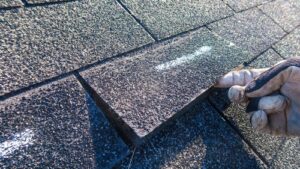Checking the condition of your roof regularly is important because it helps you catch problems early and address them promptly, before they escalate into costly issues. This practice also extends the lifespan of your roof and helps keep your entire home safe and protected.
While it’s always smart to reach out to professionals in Del Mar who specialize in roof repair to inspect yours a couple of times per year, understanding what a comprehensive inspection checklist should look like can help you stay on top of everything. Keep reading to learn more.
How to inspect your roof?
Here’s a detailed checklist designed to cover both the interior and exterior of your home thoroughly:
Exterior – ground level
Start by carefully observing your roof from the ground. That way, you can have a preliminary assessment that allows you to identify any potential problem areas and visible damage from the safety of your yard, without having to climb up. Look for:
- Algae, moss, and debris buildup. Algae and moss retain moisture, which can lead to rot, and debris can cause water pooling and potential leaks.
- Visible signs of damage, such as cracked, curling, and missing shingles. Cracked shingles can diminish your roof’s ability to shed water, curling shingles can indicate potential failure, while missing shingles expose the underlayment.
- Blockages or damage to gutters. Rust, dents, or loose hangers can prevent water from freely flowing away from your home’s siding and foundation. Clogs can also prevent proper drainage, which can lead to rot and basement flooding.
- Sagging areas. These can indicate issues with the underlayment, which could be caused by different problems, such as water damage, improper ventilation, or improper installation.
Exterior – on the roof
If you have the appropriate equipment (non-slip shoes, ladder, etc.) and feel comfortable enough to climb onto the roof, you can inspect the flashing and materials in more detail. However, if you’re uncomfortable, it’s best to leave this part to us.
Here’s what should be covered:
- Flashing around vents, skylights, and chimneys. Check for rust, tears, missing caulk, gaps, or bends in the flashing.
- Shingles. Check for any cracks or wear. For example, granule loss usually appears as bald spots.
- Seals around vents and pipes. These can crack or become loose, allowing water to seep into the attic.
- Blocked gutters or standing water. Even if they look fine from the ground level, it’s essential to check if there are any areas where water may be pooling.
Interior
A careful examination of your ceiling or attic can reveal a lot about the condition of your roofing:
- Proper ventilation. Hot, stuffy attics with insufficient airflow create the perfect environment for moisture buildup, potentially leading to wood rot, mold, or shingle failure.
- Discoloration or water stains on walls or ceilings. Water stains typically appear as yellow or brown streaks or rings. Make sure to note their size and location.
- Light coming through. When it’s sunny outside, turn off any lights in your attic and look if there are any spots where sunlight is filtering through, as these can indicate openings or gaps in the structure.
Where in Del Mar can I find reliable experts for roof repair?

